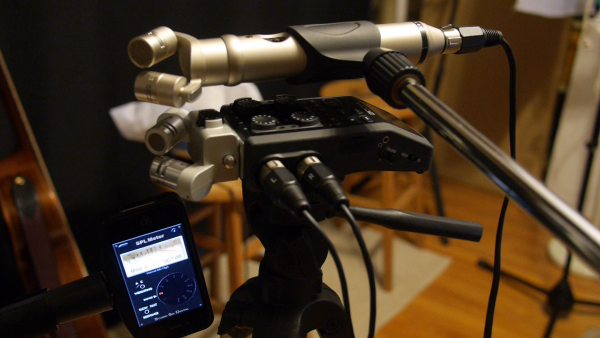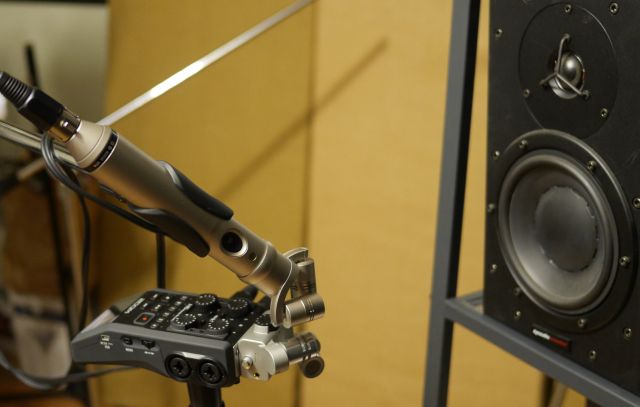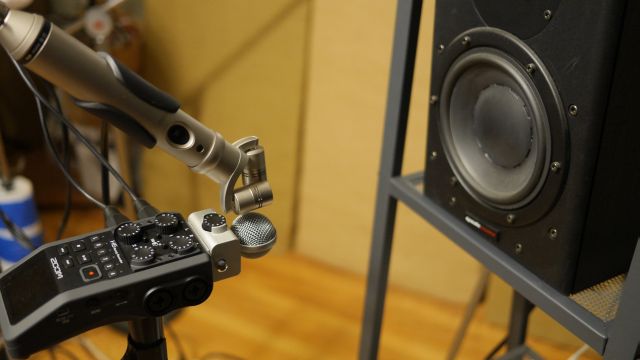Zoom has been pushing MS or Mid-Side recording technology in their recent products. The ones I know about are the MS decoder in the H4n followed by the rear-facing MS mics in the H2n. Their latest video camera, the Q2HD was the first with the distinctive ball shaped mic array housing. Now the new H6 recorder includes an MS module also featuring that ball shape, and in the “announced but not shipping” category we have the iOS mic, the iQ5 using that styling as well. Doug Young was the first H6 owner I talked with and he immediately identified a self-noise issue with the MS mic module. My initial explorations all focused on the XY mic module and the external connection preamps, but now I’ve had a chance to experiment with the MS module a bit.
What Is MS Recording?
I’ve looked at MS recording in an earlier post but it’s worth going over the basics again. The inventor of stereo was a remarkable English engineer named Alan Blumlein. He was attempting to make the voices follow movie actors as they traveled across the screen and he figured out how to do it with only two microphones for recording and two speakers for playback. He figured out three different mic configurations including one that points one mic directly at the center of the source and another perpendicular to the source. The two mics are called the mid mic and the side mic, hence the name of the technique. The two mics must be combined in a very specific way to turn these two mic signals into a conventional left-right stereo track. The mid mic pattern can vary but the side mic must be bidirectional. Since it’s tricky to make a small bidirectional condenser mic the Zoom engineers use a pair of cardioid mics wired together in opposite polarity and pointing in the opposite direction. These two mics together serve as the side mic and are perpendiular to the mid mic.

Zoom MSH-6 Mid-Side Mic Module
You can visit the Zoom product page for the H6 for more details.
Zoom, We Have a Problem
I was very pleased with my initial tests of the H6 using the XY module and the XLR preamps with external mics. All these features improved on the Zoom recorders I’ve used in the past. When I started evaluating the MSH-6 mic module I was immediately struck by the additional noise that was showing up in my recordings so I set up a comparison that might highlight self-noise from the mic module. I created a test signal with a low level beep followed by silence, then I fed this signal into the Zoom mic modules and at the same time into a Rode NT4 stereo mic attached to channels 1 and 2 of the H6. Here’s a picture of the setup:
All these samples are WAV files, 44.1 khz and 16 bit, so they won’t stream well. Use Right-Click Save Link As… or Ctrl+Click on the Mac and save the clips to your computer, then pull them into some player that lets you switch between them easily. In the picture you see the XY mic module in use. Here are two clips recorded at the same time.
You can hear people talking in the background. To give you an idea of the amount of gain in these clips, those people are downstairs and across the street speaking in normal tones. My impression from these two clips is that the Zoom XY module delivers very nicely compared to the Rode NT4. Now with the MS mic module attached, we have these two clips.
Clearly the MS mic module is generating a lot of extra noise that is not present in the NT4 or even in the Zoom XY module.
MS and Guitar
Nearly all of my recordings are solo acoustic guitar, not the hardest instrument to record but not the easiest either since the volume from the instrument can be relatively low which requires a nice quiet recording chain. To evaluate the impact of the Zoom MSH-6 module on an acoustic guitar recording, I set up my Lumix GH3, some lights, and the Rode NT4 and H6 combination to do some quick takes with first the Zoom XY then the MS module. I compiled excerpts from these takes into a video:
YouTube is OK for a quick glance, but to make a more careful comparison you can download the audio from those recordings and listen to them side by side.
In Conclusion
I’ve bought a lot of Zoom products and I look forward to their future developments, but I must say I’m not a big fan of their emphasis on Mid-Side recording. There’s really no advantage when it comes to adjusting the signal in post. With a little computer trickery it’s not hard to convert an XY recording into an encoded MS recording, where the mid and side signals can be processed and adjusted independently then converted back to conventional stereo. And when properly adjusted to a default setting MS should sound just like an XY configuration. So the only real point must be adding a marketing point.
A small single diaphragm condenser with a bidirectional pattern is clearly expensive to make, just look at the prices of Schoeps and Sennheiser models and note that there are no low cost knockoffs like we see for cardioid and omni patterns. So Zoom fakes their bidirectional side mic by combining two cardioids back-to-back.
If the MS mic configuration worked wonderfully I wouldn’t care about the implementation, but at least in the current version of the H6 the MS mic module adds a lot of noise to the recording. Perhaps this can be addressed in firmware, but I”m not very hopeful. Perhaps Zoom will recall and replace these mic modules, but I have very little hope of that either. So for me at least the MS module is going to sit in its case and annoy me. Every time I look at it I’ll think of Zoom as going for a bit of marketing and adding a bit to the cost without actually adding any value to their otherwise very impressive H6 recorder.
Update – 23 August 2013
I decided to contact tech support to see if my MS mic module is operating normally. I started off by registering my recorder at Samson Technologies because they’ve been the face of Zoom here in the US. Then I sent a message using their contact form. I received a reply promptly but was surprised to be directed to Zoom North America for issues with the H6 recorder. If you visit the site you’ll see that only the H6 is currently addressed there, while the other products are still handled through the Samson Tech site.
I registered my recorder again at the Zoom North America site and submitted my request for information, linking to this blog post for the sample tracks. I again received a very prompt reply, this time with some comments on my issue. The tech suggested that it might be worth testing the MSH-6 module in the “Off” or mono mode, which disables the side mic. I put up the H6 in front of the speaker again, with the NT4 positioned above. This time I arranged things to emphasize a single microphone, since our comparisons would focus on a mono signal.
The NT4 is the constant in these comparisons. I arranged it so the left side mic pointed directly at the speaker. Then I arranged the H6 with its XY module so that its left side mic was directly under and aligned with the Rode mic. It looked like this:
Then when I arranged the MSH-6 module, I left the NT4 in its previous position and aligned the ball of the MS module facing forward to point the mid mic at the speaker, like this:
I did a rough level adjustment then played my test signal – a short low level beep followed by silence – into each combination.
Mid Mic Clips
I pulled the clips into REAPER and converted the stereo files from the H6 mic modules into mono files. Then I used the test tone beeps along with the Sonalksis Free G meters to match the levels of the Zoom clip to its companion Rode NT4 clip. I rendered the files as 44.1/16 CD spec WAV files. Remember, you need to download these files and pull them into a tool that allows you to switch back and forth for best results.
First lets hear how the XYH-6 module compares to the Rode NT4:
Next, here’s the MSH-6 with the side mic set to “Off:”
I was curious how the MS Raw setting compares so this set of clips includes both the mid mic and the side mic in their own mono file. I didn’t match the side test tone level, instead I applied the same gain to the side mic as I used for the mid mic. The beep is much quieter in the side mic, as it should be. How’s the noise?
With the Zoom XY module I hear the noise levels to be pretty close. The Rode is slightly better, but I can live with the results from the Zoom mics. When I switch to the MSH-6 and choose the “Off” setting for the side mic the result is slightly noisier. This might be usable if not ideal, but only if I’m willing to settle for mono. Finally, the mid mic in the MS-Raw file seems pretty similar to the mid mic in mono, just as we should expect.
Since the mid mic alone is only slightly noisier than the XY mic, it appears that the side mic is contributing noticeable noise to the MS array. Sure enough, when I listen to the side mic in the MS-Raw setting it is providing little signal but plenty of noise. I’ll pass these results along to the support team at Zoom North America and see what they make of it. Meanwhile I’ll continue to use the XY module and ignore the MS module on my H6.
Update #2 – 26 August 2013
I heard back from Zoom North America tech support and their opinion is that my MSH-6 module is working normally. In other words, the level of self-noise I’m experiencing is what you should expect if you use the MS feature of your H6. So there’s a simple solution which I plan to adopt – don’t use the MSH-6 mic module. It seems a shame to me that we have to pay for this “feature” that we don’t need and in fact cannot use without sacrificing quality, but that’s the world as defined by marketing, I guess. I’m still happy with my H6 and expect to make it a central part of my video and audio recording, but I predict that this issue will become the new “bad Zoom” meme to join the “plasticky” and “weak preamps” and “distorted line in” memes that have been part of most discussions about Zoom recorders in the past.


